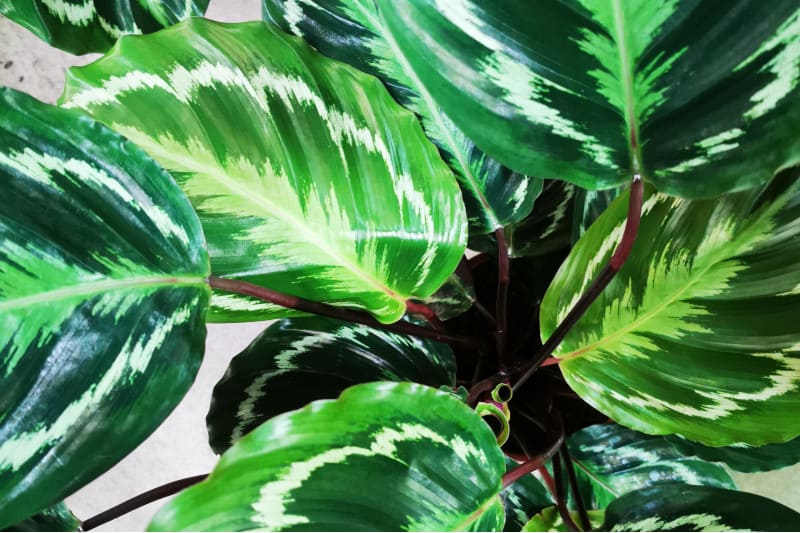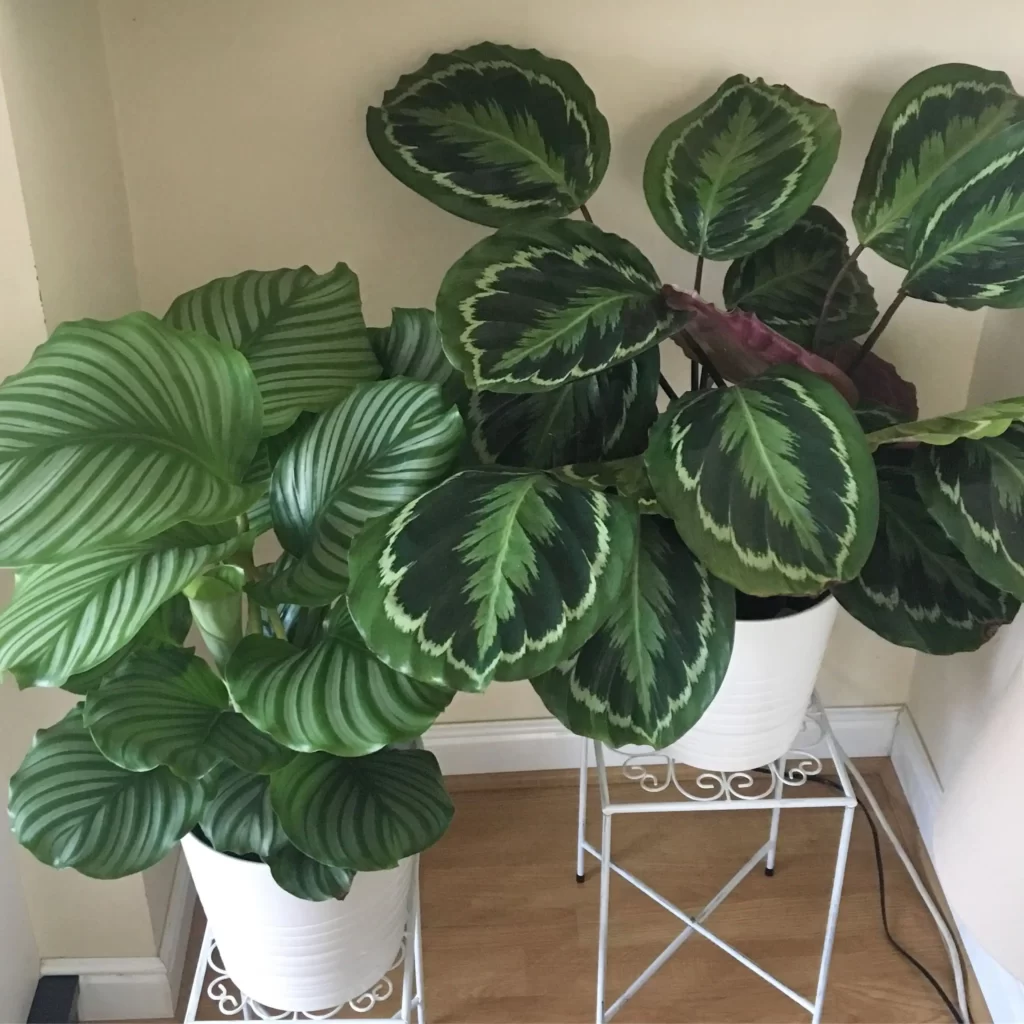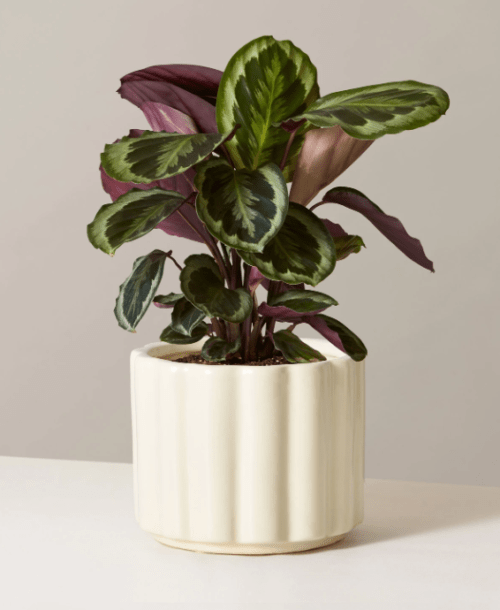Calathea ‘Medallion’ introduction

The Calathea Medallion is one of the most stunning houseplants due to its enormous, glossy emerald leaves that feature white lines and a burgundy underside. Calathea veitchiana is growing in popularity among gardeners throughout the world due to its beautiful appearance. Medallion calathea is a perennial herb that belongs to the Marantaceae family. The undersides of the plant’s enormous, medallion-shaped leaves are a deep burgundy. At night, the calathea medallion’s leaves will curl up like those of a prayer plant. The calathea medallion’s huge oval leaves emerge from a single stem that reaches a maximum height of around three feet. Because of their sluggish growth rate, Calathea veitchiana medallions are most easily propagated by dividing their tuberous roots (also called rhizomes) and replanting the resulting offshoots. Calathea medallions are only found in warmer climates, yet they are highly sought after as houseplants in colder places because of their unique appearance. They do well in USDA plant hardiness zones 8 through 11. Calatheas, which are members of the Marantaceae family and are commonly known as prayer plants, has an amazing ability: they adjust their leaves to the sun’s position throughout the day and night. It gets its common name from the way the leaves fold up at night, looking like a supplicant might do in prayer. Calatheas, which originate in the tropics of the Americas, is the quintessential greenhouse plant, thus providing them with the ideal conditions is crucial to their survival. Another benefit of this tropical plant is that it does well in low-light settings, so it can liven up any boring nook. But the Calathea Medallion needs more attention than other houseplants. We don’t want to dissuade novice gardeners from getting a Calathea Medallion, but we do want to make sure they understand what’s involved in keeping it healthy and happy.
About Calathea Medallion
You can feel safe letting your kids play around with a Calathea Medallion because it is not poisonous to either humans or animals. However, Calatheas have been rumored to be edible, so it’s best to keep them out of reach of inquisitive dogs.
Calathea is a genus with hundreds of subspecies. Some of the most common varieties are Calathea veitchiana ‘Medallion’, Calathea ornata, Calathea roseopicta ‘Dottie,’ and Calathea lancifolia, often known as rattlesnake calathea.
Calathea leaves have a variety of uses, including as a food wrap and a material for arts and crafts, throughout its native region. It is common practice in some regions of Brazil to utilize these leaves for both basket weaving and the wrapping of fish before transportation. Large, durable leaves from the Calathea tree are commonly used as container material in Colombia. Even so, the rice containers made in rural Thailand are among the most well-known of the country’s handicrafts.
Many animal and plant species are in danger of going extinct because their natural habitats are being destroyed. As the sale of Calathea leaves is a significant economic driver in the area, this has the potential to have far-reaching consequences.
Calathea Medallion can be successfully cultivated in outdoor conditions if the appropriate temperature is maintained. It’s a lovely accessory for a patio or porch.
Characteristics of the Calathea Medallion: An Outline
Large, showy foliage and vibrant flower clusters make calatheas a popular houseplant. Many insects find a haven in the puddles of water that form on their leaves in the wild.
During the night, the leaves of a calathea plant will fold over, showing the vibrant colors on the underside of the leaves. The technical term for this is nyctinasty.
To sway its leaves, the Calathea medallion modifies the water pressure in the enlarged pulvini nodes (joints) at the leaf’s petiole’s base. It’s speculated that the plant does this to track the sun’s path and increase its exposure to light.
Unlike their wild counterparts, Calathea veitchiana grown in a home environment will never flower and provide an aroma. Those who garden and experience hay fever may benefit from this.
Even though this plant lacks blooms, don’t let that stop you from appreciating its striking foliage.
Medallions, when they reach maturity, can reach a height of around 2 to 3 feet (60 to 90 cm). The rate of its growth is somewhere between rapid and rapid.
Planting a Medallion of Calathea

The Calathea Medallion is extremely particular about its lighting needs. Sunburn occurs on the leaves of tropical plants when they are exposed to strong light. If the plant is getting too hot near the window, you should relocate it. Similar to their natural environment, medallion plants do best in mild light. Although Medallions can thrive in north-facing rooms with limited light, they will look better and retain their colorful leaf patterns with a little more exposure to light. A Calathea should be kept in a well-lit but shaded space inside. Keep your Calathea Medallion away from any sources of heat, such as radiators. The leaves will begin to curl if the temperature is too high. Maintain a constant temperature of 65 to 80 degrees Fahrenheit (18 to 29 degrees Celsius) throughout the year. When leaves are yellow, that means the plant is getting too much direct sunshine. Put it somewhere where it will be bathed in indirect light. It’s important to keep in mind that the Calathea Medallion is sensitive to temperature changes and draughts, therefore it should be kept away from any doors or windows. Medallions are great for bathrooms and kitchens since they are resistant to humidity and can function in low-light settings.
For all their haughtiness, this more than makes up for it.
Beautiful, easy to grow, and great for the air quality, the Calathea Roseopicta ‘Medallion’ may be found in a pot of just 4 inches in diameter.
solely produced by Wekiva Foliage, who also handles packaging and shipping. The gorgeous Calathea Medallion, which belongs to the praying plant family, is one of nature’s most breathtaking works. Its huge “medallion”-shaped leaves look as if they were painted with brushstrokes of deep green and Fuschia tones, and it grows into a bouquet of unmistakably vivid foliage.
The Calathea Medallion is a fast-growing plant that can reach a height of two feet under ideal conditions.
The leaves of the calathea medallion variation are round to rectangular and have a dark purple tint, with a conspicuous silver midrib, or central leaf vein. Lower light levels, high humidity, and moderate soil wetness are ideal for Calathea medallion plants.
As part of their daily circadian rhythm, calatheas raise and lower their leaves, earning them the nickname “prayer plants.”
The frequency of watering should be adjusted based on the amount of light available but is generally once every two weeks. Don’t water the soil until it’s almost completely dry. Up to about 2 inches deep, the soil should be nearly dry.
A sign that the environment is too dry is when the captivating leaves of your Calathea Medallion begin to brown up or curl. Spray it with distilled water at least once a day to solve this issue. Don’t get too close to the leaves; instead, spritz the air around the plant. A pebble tray or humidifier is another option. Humidity levels around 50% are considered optimal.
Be sure that the temperature in your yard, on your porch, or your balcony does not drop below 55 degrees Fahrenheit (12 degrees Celsius) if you plan on keeping a Calathea Veitchiana plant. The plant may die or suffer irreparable harm if the temperature drops too low. If you want to avoid this from happening, make sure to bring it inside on chilly evenings. Place your Medallion in a south-facing window so that it receives only morning sunlight. Burning of the tips or edges is a typical problem with tropical plants. Your city water supply may be to blame for this. Use bottled or filtered water, or let tap water set out for a day to let the fluoride and chlorine evaporate, to avoid this. Avoid using shine agents on the leaves, but make sure to clean them with a moist cloth when they get dusty.
Read More: Best Spider Plant in Bangalore
Planting Calathea Medallion
The Calathea Medallion thrives in a potting mix with plenty of drainage holes. A combination of potting soil, peat moss, and perlite would make for excellent soil. Charcoal, orchid bark, vermiculite, and coco coir are more options. Soil needs to be able to retain essential moisture and nutrients while also draining effectively. Fungus problems might develop in soils when there is an excessive amount of bark or compost. Before purchasing the plant, you should evaluate the soil’s compaction and, if necessary, break it up a bit. Inspect the containers to ensure there are adequate drains. You may help the pot drain better by lining the bottom with pebbles. When the tray becomes full, dump it immediately so the plant doesn’t sit in water. Keep in mind that terracotta pots dry out more quickly than their ceramic or plastic counterparts. Fertilize the Calathea Medallion once a month from spring until late summer. Fertilization should be reduced or halted entirely during the colder winter months. A moderate application of fertilizer diluted to one-fourth strength is recommended. Leggy growth, root burn, and ultimately death can result from an excess of fertilizer in the soil. The Calathea Veitchiana you have might benefit from a periodic flush. Repotting your Calathea once a year or twice a year will help the soil retain essential nutrients. The roots might spread out more if you repot your plant in the spring before the growing season begins. What’s more, it helps fix any fungus problems in the soil.
Five Different Types of Calathea
Different varieties of calathea plants have their quirks. Listed below are some of the most sought-after calathea plants currently available.
- Calathea orbifold, sometimes known as the orbifold prayer plant: The Calathea orbifold plant is nearly three feet tall, making it far taller than most calathea species. Its leaves are wide and floppy, but they still have that distinctive pinstripe pattern that’s characteristic of general prayer-plants.
- Goeppertia ornate, often known as pinstripe calathea, is a kind of calathea with distinctive, veined leaves that grows best in low light and high humidity. To keep the soil around this plant moist, mist it with distilled water periodically.
- Due to its scaly, variegated leaf design, Calathea lancifolia is often referred to as a rattlesnake plant (Goeppertia insignis syn. Its slender leaves set it apart from other calathea varieties.
- Medallion plant Calathea roseopicta has dark purple and pink leaves with touches of green. Goeppertia roseopicta, a synonym of Calather roseopicta. In a medium-light, humid setting, it thrives.
Leaves of the zebra calathea (Goeppertia zebrina, also known as Calathea zebrina) are striped in a zigzag pattern of light and dark green. Although they have attractive evergreen foliage, they cannot withstand direct sunshine.
When Should Calathea Medallion Be Planted?

Calathea medallions can be grown either indoors or outdoors, but they’re better off being brought inside before the temperatures drop too low. If you follow those steps, you may put your calathea in the ground at any time of year. Please remember that this plant does best in temperatures ranging from 55.5 to 60.0 degrees Fahrenheit.
Taking Care of Your Calathea Medallion Plant
Having a thriving calathea medallion plant in your own house can be a struggle, but it’s possible with the appropriate care. Rhizomes, the underground tuberous roots used by plants to spread, are best propagated via division. If you want to cultivate a calathea medallion plant, here’s how to do it! Get the ground ready. As a planting medium, you should use porous potting soil and sow your seeds in a container with drainage holes. For better drainage and air circulation, combine perlite and peat moss with your potting soil.
Separate the rhizome roots. To start a new calathea medallion plant, you need to start with a slice of its rhizome (or tuberous root) (preferably during the early spring). Remove part of the soil from around the roots of an established calathea plant. Pulling at the roots with your fingers will reveal a healthy tuberous root connected to a growing stem with a few shoots protruding from it. To separate this shoot from the parent plant, cut it off.
Just replant the clipping. After dividing the root, dig a hole deep enough to accommodate it and the stem, and then fill it in to keep the stem in a vertical position. Care for your fresh cutting by placing it in a spot that gets lots of bright, indirect sunshine and watering it regularly.
How to Take Care of a Calathea Medallion Plant
Calathea medallions can be difficult to maintain for inexperienced gardeners. Still, with the right attention and maintenance, your calathea medallion can flourish.
- Douse the situation with moisture. As these plants originate in the tropics, they require a humid environment of moderate to high humidity. Humidity can be increased by misting the plant with lukewarm water or by keeping a humidifier running in the room.
- If you want healthy medallion plants, fertilize them around once a month during the warm growing season. In the spring and summer, feed these foliage plants a solution of liquid houseplant fertilizer.
- If you want to plant your medallion outside, do it in a shaded place (an area with partial shade or dappled, indirect sunlight). While they thrive in bright indirect light from an east or south window, these houseplants can also survive in low to medium lighting conditions. Don’t put plants near draughty doorways or radiators, or anywhere else where the temperature will fluctuate drastically.
- Keep the water at room temperature. Do not shock the roots of your calatheas by watering them with cold water; instead, use water at room temperature. Since calathea medallions can be damaged by minerals found in tap water (such as chlorine and fluoride), it’s best to use distilled water or filter your tap water before watering them. The mineral accumulation can be washed away with some top-tier water.
- Keep an eye out for leaves that have turned brown or yellow. If the edges of your calathea leaves start to become brown and crispy, your plant is receiving too much direct sunlight. Transplant the calathea to a shadier spot and remove any faded leaves (or only trim away the parts that are turning brown). Overwatering or pest damage could be to blame if the leaves begin to turn yellow. Keep an eye out for insects. Pests including spider mites, thrips, aphids, and mealybugs frequently attack calathea medallions.
- Leaves can be wiped down with water, or an organic insecticide such as neem oil can be applied to rid the plant of pests. Planned watering. Be sure to only water your clothes until the top inch of their soil or potting mix is completely dry. Too much watering might cause root rot and fungus gnats. However, (underwatering can also lead to dry, curled leaves.)
Medallion for Watering Calathea
The Calathea Medallion is not a drought-resistant plant and needs to be watered frequently. Incorrectly watering tropical plants on a regular schedule is a common oversight. Dried leaves, fungus gnats, root rot, and other issues can be caused by either watering too infrequently or too frequently. To know when to water, it is best to check the soil’s moisture content first. Check the moisture content of the top inch and a half (2.5 cm) of potting soil with your finger. Hold off on watering for a couple of days and see if it still needs it. If the soil appears dry, give the plant a good soaking and then remove it from the tray. Under-watering is preferable to over-watering for most Calatheas, including Medallion, Zebra, and Rattlesnake kinds.
The Spread of the Calathea Medallion
Calathea medallions, unlike many other plants, cannot be propagated simply by taking cuttings; instead, root division is performed soon before planting is required. They don’t like to be messed with, so you’ll need a healthy, established mother plant to start new ones from. Calatheas, when well-cared for, produce new leaves that add to the plant’s aesthetic appeal. Once you unpot the plant, you’ll discover that it can be cut up quite easily. Once you’ve decided where to make your cuts, disentangle the roots by hand. When this is not an option, a clean, sharp knife should be used to sever the tuber. Plant the cutting in a similar but new container of potting soil and water it well. Over the next few weeks, the soil should be kept damp but not soaked. Don’t expose the new specimen to bright light right quickly. Maintain a high humidity level and mist as necessary. There should be new leaves on your Calathea Medallion in about 2–4 weeks.
It’s well worth the effort, as Calathea Medallion is a queen worthy of your special care. This tropical plant is a favorite among gardeners because of its beautiful emerald-green leaves and white stripes. Such a stunning creature even follows a day-night cycle! If you’re willing to put in some work, the Calathea Medallion will pay off by brightening even the darkest and most hidden areas of your home.
Get More: Best Aglaonema Plant in Bangalore

